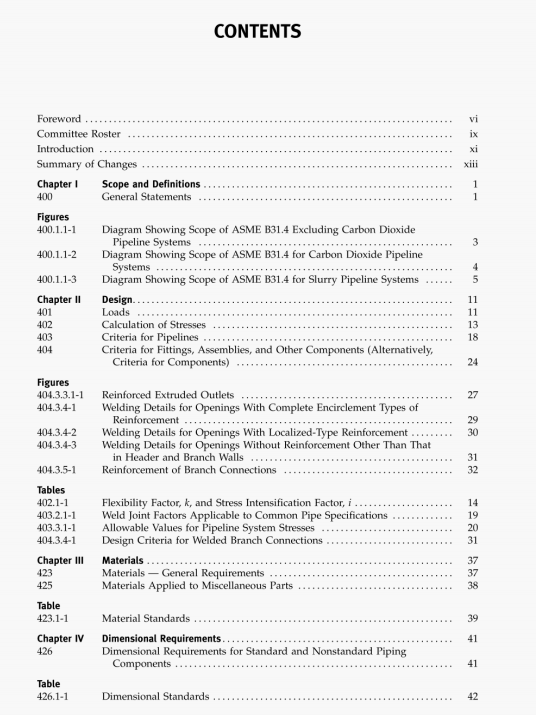ASME B31.4 pdf download.Pipeline Transportation Systems for Liquids and Slurries.
400 GENERAL STATEMENTS
(a) This pipeline transportation systems Code is one of several sections of The American Society of Mechanical Engineers Code for Pressure Piping, ASME B31, and it is the responsibility of the user of this Code to select the applicable Section. This Section is published as a separate document for convenience. This Code is intended to apply to pipeline systems transporting liquids including, but not limited to, crude oil, condensate, liquid petroleum products, natural gasoline, natural gas liquids, liquefied petroleum gas, carbon dioxide (supercritical), liquid alcohol, liquid anhydrous ammonia, produced water, injection water, brine, biofuels, and slurries. Throughout this Code, these systems will be referred to as liquid pipeline systems.
(b) The requirements of this Code are adequate for safety under conditions normally encountered in the operation of liquid pipeline systems. Requirements for all abnormal or unusual conditions are not specifically provided for, nor are all detaiLs of engineering and construction prescribed. All work performed within the scope of this Code shall comply with the safety standards expressed or implied.
(C) The primary purpose of this Code is to establish requirements for safe design, construction, inspection, testing, operation, and maintenance of liquid pipeline systems for protection of the general public and operating company personnel, as well as for reasonable protection of the piping system against vandalism and accidental damage by others, and reasonable protection of the environment.
(d) This Code is concerned with employee safety to the extent that it is affected by basic design, quality of materials and workmanship, and requirements for construction, inspection, testing, operation, and maintenance of liquid pipeline systems. Existing industrial safety regulations pertaining to work areas, safe work practices, and safety devices are not intended to be sup planted by this Code.
Installation and operational on-bottom stability design conditions shall be considered.
403.6.2.2 Design Current Conditions. Operational design current conditions shall be based upon an event having a minimum return interval of not less than 100 yr.
403.6.2.3 StabIlity Against Currents. The submerged weight of the pipe shall be designed to resist or limit movement to amounts that do not cause the longitudinal and combined stresses to exceed the limits specified in Table 403.3.1-1. The submerged weight may be adjusted by weight coating and/or increasing pipe wall thickness.
Current direction shall be considered.
The pipeline and its appurtenances may be buried to enhance stability.
Backfill or other protective covering options shall use materials and procedures that minimize damage to the pipeline and coatings.
Anchoring may be used alone or in conjunction with other options to maintain stahilit The anchors shall be designed to withstand lateral and vertical loads expected from the design wave and current conditions. Anchors shall be spaced to prevent excessive stresses in the pipe. Scour shall be considered in the design of the anchoring system. The effect of anchors on the cathodic protection system shaU be considered.
Intermittent block type, clamp-on, or set-on weights (river weights) shall not be used on pipelines where there is a potential for the weight to become unsupported because of scour.
403.6.2.4 Shore Approaches. Pipe in the shore approach zone shall be installed on a suitable abovewater structure or buried or bored to the depth necessary to prevent scouring, spanning, or stability problems that may affect integrity and safe operation of the pipeline during its anticipated service life. Seasonal variation in the near-shore thickness of seafloor sediments and shoreline erosion over the pipeline service life shall be considered.
403.6.2.5 Slope Failure and Soil Liquefaction.
Slope failure shall be considered in zones where it is expected (mudslides, steep slopes, areas of seismic slumping). If it is not practical to design the pipeline system to survive the event, the pipeline shall be designed for controlled breakaway with provisions to minimize loss of the pipeline contents.
Design for the effects of liquefaction shall be performed for areas of known or expected occurrence. Soil liquefaction normally results from cyclic wave overpressures or seismic loading of susceptible soils. The bulk specific gravity of the pipeline shall be selected, or alternative methods shall be selected to ensure both horizontal and vertical stability
Seismic design conditions used to predict the occurrence of bottom liquefaction.
ASME B31.4 pdf download
